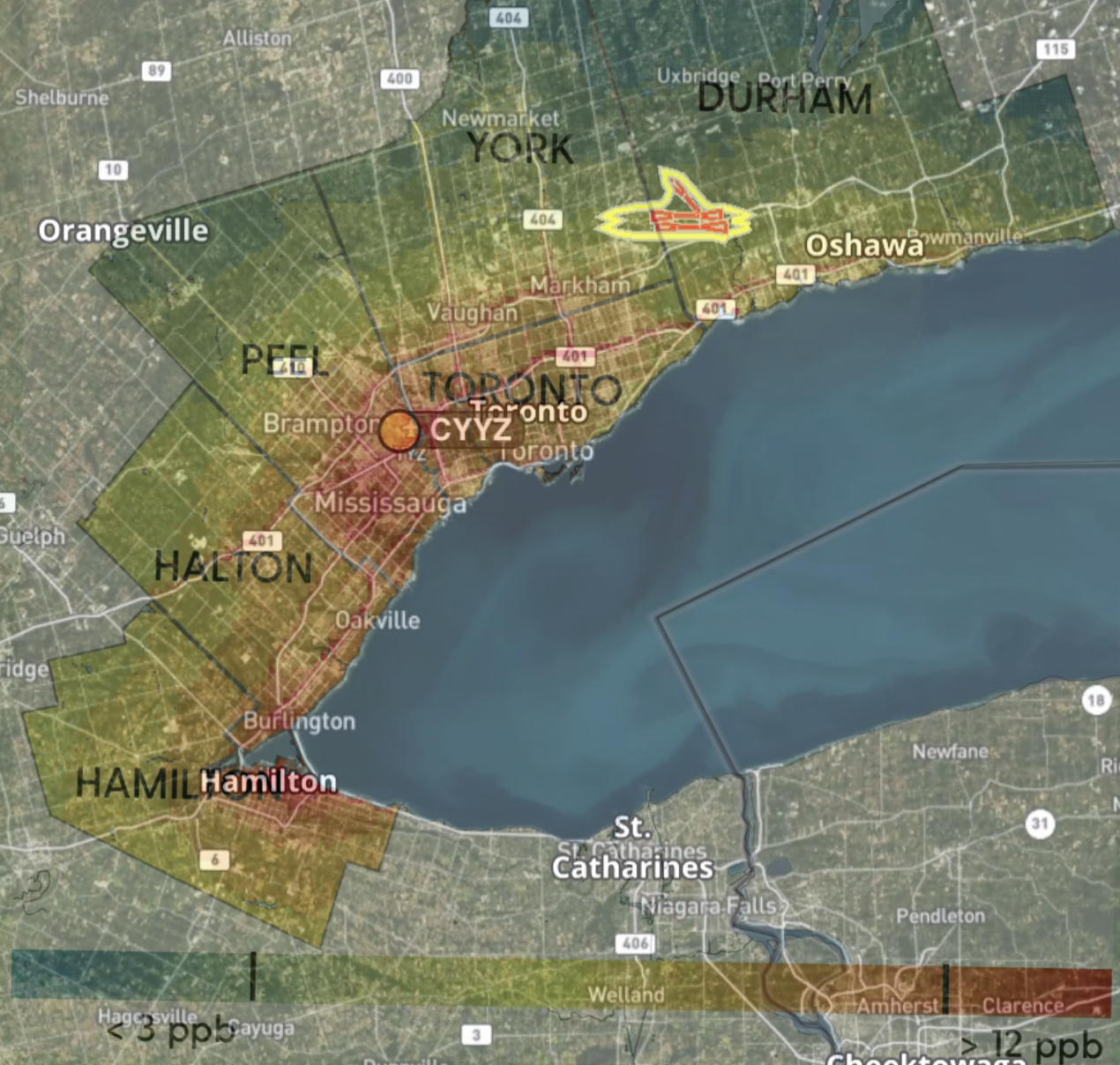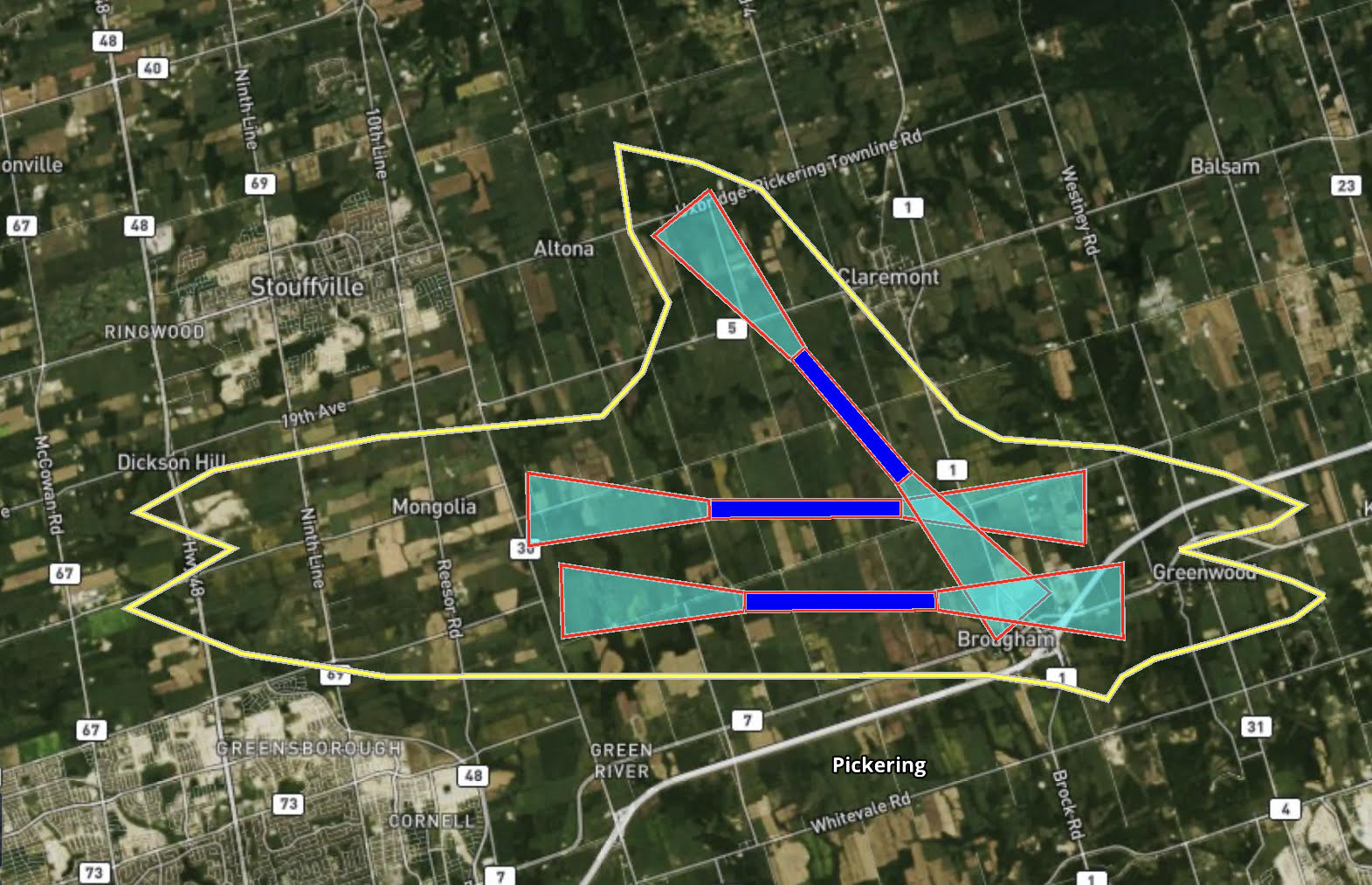By Mark Brooks

One of the un-championed benefits of the new airport in Pickering will be its distance from nearby subdivisions. Unlike other Toronto airports that will need to be expanded if Pickering is delayed, the new airport is kilometres away from subdivisions. It will be buffered by both a new park as well as the Ontario Greenbelt. The resulting diversion in noise and air pollution from the heavily populated neighborhoods near the Toronto region’s existing airports will be a significant health and lifestyle benefit to hundreds of thousands of citizens.
Pollution levels today within the boundaries of a large airport are similar to or less than those of a freeway. But this can be 10 times higher than a park just two kilometers further away. The toxins are also similar, including sulphur oxides, carbon dioxide, lead, nitrogen oxides, and volatile organic compounds (VOCs).
Each of these pollutants brings its own array of issues. VOCs, for instance, have been linked to headaches and eye, nose, and throat irritation. In the past, studies have found higher levels of neurological issues, kidney and liver problems linked to pollution from freeways and some large airports. Pollution at the levels found near a major freeway like Highway 401 has been linked to increased levels of cancer, lymphoma, myeloid leukemia, and depression.

Unlike a freeway, an airport is a highly controlled environment managed by strict levels of training and equipment maintenance standards. To reduce health risks further, the aviation industry is moving forward with sustainable aviation fuels from renewable sources that create less pollution and GHG (Green House Gas) emissions. It is implementing new standards for jet engines, as outlines in ICAO Standards and Recommended Practices (SARPs). These initiatives are expected to significantly reduce pollution and emissions.
If reduced air quality isn’t enough reason to stop expanding airports surrounded by housing, there’s also the noise factor. Excessive noise exerts a negative influence on health for several reasons. First, when the noise occurs at night, it disturbs sleep. Also, noise causes the body to release stress hormones, which can negatively impact the immune system, the cardiovascular system, and even cholesterol levels. The more noise, the worse the effects.
The noise profile in figure 3 was created using the noise contour mapping produced by Transport Canada in 1986, for Pickering Airport, which based its modeling on 1980s aviation technology. In the last four decades new aircraft have become significantly quieter and much more fuel efficient thanks to new jet engine and airframe technology. It is expected that the noise profile for Pickering airport will be tighter than the Transport Canada model. For example, Air Canada claims that its new Airbus A220 (Bombardier) has a 75 per cent reduction in noise footprint compared to the aircraft it replaces. With the aircraft and engines operating at a more efficient and optimal rate, the aircraft emits 20 per cent less carbon dioxide (CO2) and 50 per cent less Nitrogen oxides (NOx) than an aircraft made just a decade earlier. The AirBus 220 is four decades ahead of the jet technology used in the original noise model.
An update in 2018 to the PASZR (Pickering Airport Site Zoning Regulations) provides for a smaller three runway configuration. Once a winning design is chosen an updated NEF can be produced showing refined noise contours for the new airport.
Even with advances in aviation technology, why would anyone promote the expansion of Oshawa or Waterloo Airports, as a way to delay Pickering, with so many nearby homes? It is a question that Durham region residents should be asking their elected officials. A local federal MP, Jennifer O’Connell, has repeatedly promoted expanding other Toronto airports over building a new airport in Pickering. As an example, there are thousands homes that exist today only two kilometres or less from nearby Oshawa airport.
Note: In the recently released KPMG ASA (Aviation Sector Analysis ) report, a number of Toronto airports are listed as needing to expand in order to delay building Pickering airport.

None of these airports have expansion plans to the level described in the report. Given the evidence that living next to an airport is not ideal, Transport Canada has created guidelines for development around airports. The Pickering Lands have been zoned and set aside for decades with noise and health regulations in place. In addition to thousands of acres of land for an airport, the federal land reserve also includes thousands of acres to act as a buffer including green space, farmland and a new industrial zone. Some of this has been transferred to Parks Canada to form part of the new Rouge National Urban Park. This will ensure that, even in the hot Toronto Real-estate market, the nearest subdivision will always remain kilometres away.
Current Transport Canada noise level guidelines use NEF (Noise Exposure Forecast) modeling to provide recommendations for residential land use. Caution should be used in building in a NEF 25 zone and no new homes should be built inside a NEF 30 zone. Development around the new airport is conforming with theses existing Transport Canada Standards on aviation noise. This includes the new Seaton residential areas to the south and the proposed Veraine development to the east. Both appear to be outside the NEF 30 and NEF 25 areas. The existing community of Claremont is at least outside the NEF 30.
The decades of careful planning for Pickering Airport has created a perfect solution to provide the aviation infrastructure needed to support a growing city while not burdening it citizens. All our political leaders need is the will power to resist the lobbying by the self-anointed to divert a billion-dollar public land reserve into the hands of a few, and to implement the long planned new airport in Pickering. The sooner the better.
References:
Noise Exposure Forecast and Related Programs (canada.ca)
ICAO_EnvironmentalReport2016, see Chapter 3 health and Aviation
Assault on Oshawa Airport Misguided – Friends of Pickering Airport
Solving Torontos Jet noise problem – Friends of Pickering Airport
Pickering a Better Alternative to Oshawa – Friends of Pickering Airport
How loud will Pickering Airport be? – Friends of Pickering Airport
Aircraft noise is linked to raised risk of cardiovascular disease | The BMJ
TRAQ – University of Toronto Transportation and air quality research group
Highway TRAP: Could the air you breathe be harming you? | Toronto.com
Where did you get that map. (3)
“Mongolia”. ……..crazy
Mongolia is a hamlet at the corner of Elgin Mills and Reesors Road. There is an urban myth around the name, I have been told that the founder wanted to call the Hamlet California but that name was taken. He then decided to call it Mongolia instead.
I am sure it is as you say. The point is the map. Plotting on a google base ensures ongoing currency, translated between mediums (sat. and various other formats), and is scalable. See Land over landings/ Be informed/maps …”where is my house”.